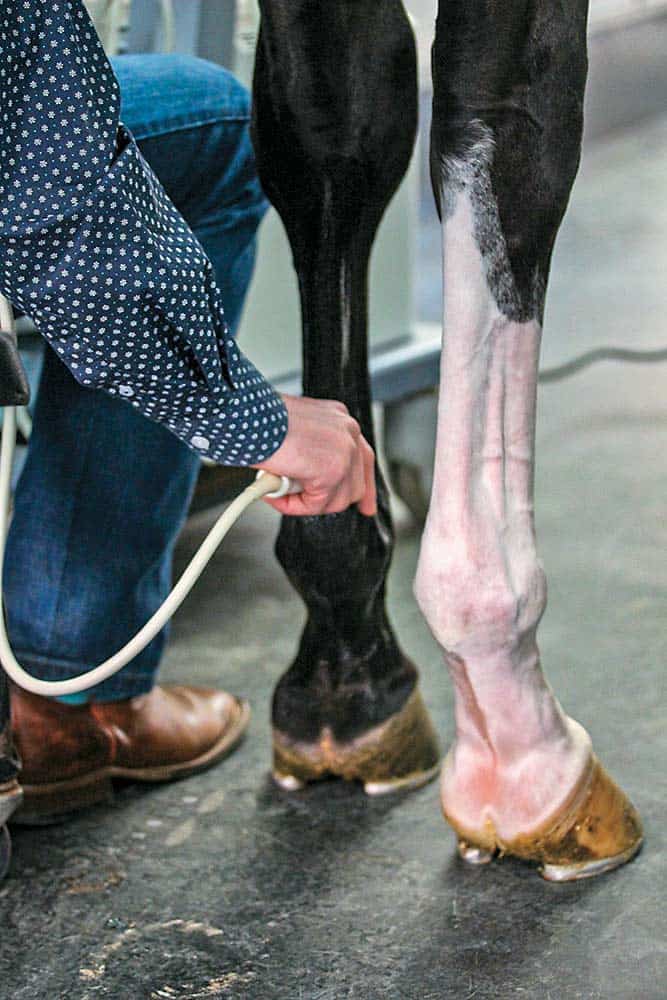Equine Tendon Injuries: Reducing the Strain

What Do I Do if I Suspect an Injury?
The classic signs of tendon injury in horses include general symptoms of inflammation: heat, pain, and swelling. Depending on where the injury is located, you might not detect obvious swelling or heat (for example, deep digital flexor tendon injuries within the hoof capsule don’t cause overt swelling and are best diagnosed with MRI). Tendon injuries of the mid-metacarpal (or cannon bone) region, however, often cause noticeable swelling, heat, and pain upon palpation. Initially, tendon-associated lameness can be severe, depending on the extent of the injury and its severity and chronicity.
If you suspect your horse has a tendon or soft-tissue injury, connect with your veterinarian immediately to get an appropriate diagnosis and begin therapy. Most commonly, a complete musculoskeletal and lameness evaluation will help the veterinarian determine which soft tissue structures are involved. Your vet might recommend an ultrasound evaluation as a first-line imaging tool to assess tendinous tissue, but MRI evaluation might also be indicated in some cases to further characterize the injury. Once your veterinarian has made a diagnosis, you can discuss treatment options to get your horse on the road to recovery.
My Horse Does Have a Tendon Injury … Now What?
The body’s intrinsic tendon repair process involves three continuous phases. The initial inflammatory phase typically occurs during the first one to three days following injury. Initial triage strategies usually consist of decreasing inflammation using cryotherapy (icing), rest, anti-inflammatories, and supportive care. The subsequent phases of repair (two to 28 days) and remodeling (60 days onward) are characterized by tissue reorganization and scar tissue formation. Once you and your veterinarian have gotten the initial pain and inflammation under control, you can aim rehabilitation strategies toward encouraging organized scar tissue formation that more closely resembles the tendon’s uninjured architecture.
Several treatment options are available for tendon injuries, yet no singular “one-size-fits-all” therapy currently exists. Researchers have described significant success using mesenchymal stem cells to treat tendon injuries in racehorses, with the most notable statistic being a significantly reduced re-injury rate. Despite the exciting research around biologic treatments such as these, controlled exercise and physical therapy remain the most important cornerstones of tendon healing.

Eccentric loading exercises have been shown to be particularly effective. These involve lengthening the muscle or tendon fibers while they’re load-bearing. Take, for example, the “down phase” of a biceps curl or a heel raise in humans. While the exact mechanism behind its therapeutic effect remains unknown, researchers believe this controlled mechanical stimulation helps the body’s scar tissue become more organized and functional.
Horses most commonly perform eccentric loading through assisted physical therapy exercises such as the “withers pull” (applying gentle lateral pressure to the side of the withers until the horse shifts his weight subtly toward your pull; hold that stretch for 3-5 seconds).
Similarly, controlled forelimb loading can help strengthen the soft tissues of the entire limb, including the supportive musculature of the shoulder, elbow, carpus (knee), and digit. Other eccentric physical therapy aids include surface changes, ground pole work, backing exercises, and modifications of the withers-pull exercise. Your veterinarian can prescribe specific therapy recommendations.
In summary, stem cell and physical therapy represent promising strategies for tendon repair. Recognizing the clinical signs, contacting your veterinarian, and getting appropriate treatment and rehabilitation plans in place will ultimately lead to the fastest recovery.
Written by:
Sherry A. Johnson, DVM, MS Dipl. ACVSMR
Related Articles
Stay on top of the most recent Horse Health news with











